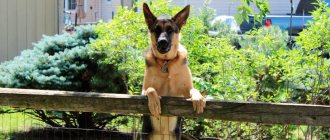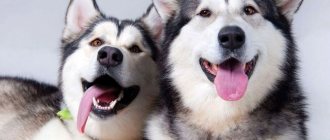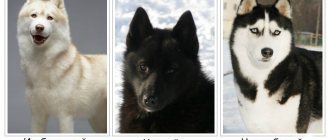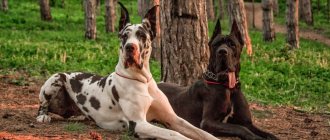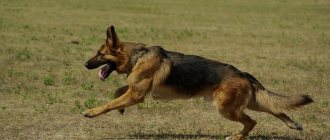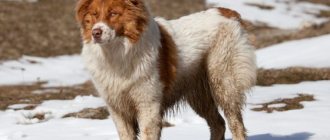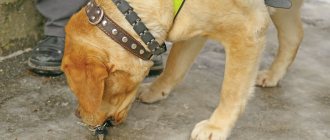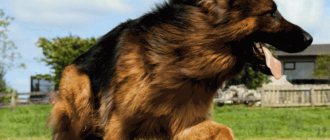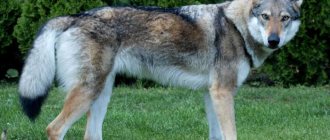Who are mixed-breed dogs?
By mixing different breeds, breeders often get mixed breeds. These are dogs that do not have a breed, but are not mongrels either. Depending on what breeds were crossed, the resulting mestizos can cost incredible amounts of money.
The attitude towards such dogs is ambiguous. Some people like their unusual appearance, which combines the characteristics of their favorite breeds. Someone is not so friendly, not understanding why purebred breeds are spoiled. By the way, mestizos are often called half-breeds. In addition, they can combine the characteristics of not only two breeds, but also three, and sometimes four.
Puppies from a Shepherd-Husky mix will also be called mixed breeds. Each breed has its own advantages and disadvantages. Which characteristics will appear in the resulting mixed-breed puppy will become known only as it grows up. Therefore, before breeding dogs from a shepherd-husky mix, you should be prepared for some very unexpected consequences.
How is Shepski used?
This German Shepherd-Husky cross is included among the working and herding breeds. Today, Shepskis are widely used for work in the following areas:
- film industry;
- law enforcement agencies;
- search and rescue activities;
- military service.
But such activity is only possible if Shepsky has completed a training course with a professional dog handler. These animals are excellent for protecting the yard and home even without quality training.
This animal can be included among the universal ones, since Shepskis are perfect both for fulfilling their official goals and for true friendship.
Considering all the properties of the animal, it is quite possible to keep it outside, since this breed is the descendant of two cold-loving dogs. Nevertheless, these dogs do not inherit the ability to move long distances from their husky mother; they are characterized by much less endurance, which is why they are not racers.
Metis is not a mongrel!
As we have already said, mestizos are not mongrels. These are, of course, dogs without a specific breed, however, they are not considered mongrels. Judge for yourself, how can a dog bred from such noble breeds as husky and shepherd be considered a mongrel?!
However, the question still arises: what is the difference between a mestizo and an ordinary mongrel. The answer is quite simple. In the appearance of a mestizo, the external signs of mixed breeds are clearly visible. That is, a puppy from a mixture of husky and German shepherd, for example, will look like both a husky and a shepherd. If not two breeds, but more, are crossed, then all of them will be visible in the appearance of the mestizo.
At the same time, the external characteristics of the mongrel will be somewhat different. The mixed breeds cannot be traced in their appearance.
Feeding and diet
The German Shepherd-Husky mix can eat both ready-made food for active adult dogs and homemade natural food. In the second case, the pet’s diet should be varied and complete.
It can be based on protein products of animal origin, for example, lean meat or offal, with the exception of lungs, liver and udder.
Lungs are of little use, excess liver in the diet is harmful, and udders are too fatty for dogs - therefore, these foods are best given in small quantities.
The meat should be supplemented with buckwheat or rice porridge, as well as fermented milk products such as kefir, low-fat natural yogurt and, of course, cottage cheese. It is useful to add fresh and boiled vegetables, as well as fruits and herbs.
IMPORTANT!
In order to provide the Shepsky with all the necessary nutrients, it is recommended to periodically give the pet vitamin and mineral supplements.
The character of the mestizo
It is quite difficult to predict what kind of character a mixed-breed puppy will have, in particular from a husky-shepherd mix. Each dog, like a person, is individual. She will take some traits from her dad, some from her mom. It's just which ones from whom - it will be a surprise in the future. For example, by mixing dwarf breeds, mestizos turn out to be cowardly, nervous, and can even be aggressive and cocky. While guard and guard dog mixes can be stubborn and difficult to train.
Before crossing breeds, you need to carefully study the characteristics of mom and dad, and, if possible, the entire pedigree. This will help highlight the dominant characteristics of the breed. After breeding the puppies, you need to observe them for some time to determine what kind of character they have.
Puppy health
The health and immunity characteristics of mestizos are often higher than those of purebred breeds. This is due to the fact that genes are mixed and the puppy takes only the best qualities from each breed. As a rule, hereditary diseases are not transmitted from parents in this case.
However, even though puppies from a Husky-Shepherd mix, or any other crossbreed, are healthier, this does not mean that mixed breeds will not get sick. They, like all animals, require appropriate care and timely treatment.
Husky habits
Before breeding puppies from a husky-shepherd mix, you need to study the characteristics of each breed. It is necessary to find out which characteristics will be leading, that is, dominant. It is dominant characteristics that are often passed on to offspring. Therefore, it is better to know which habits a mestizo can take from a husky, and which from a shepherd dog.
The Husky breed is known to be friendly. They are wary of strangers, but do not show aggression. The animals are quite sociable, they are able to live calmly in the same territory with other dog breeds. Huskies are also good with children, making them a good option for families with small children.
This breed has no guarding instincts, so they are not suitable as a watchdog. Huskies are also stubborn and independent. They often strive to do as they see fit, even if this contradicts the aspirations of the owner. In such a situation, the owners need to become a leader for the dog, as it would be in the animal’s natural habitat (huskies live in packs and each team has a leader).
You also need to keep in mind that huskies love to hunt. Of course, they do not attack their neighbors where they live. However, they will happily hunt other people's cats, chickens, rabbits and other small animals.
Advantages and disadvantages
pros:
- They are distinguished by their beautiful and original appearance.
- Friendly.
- Sociable.
- Devoted.
- Smart and quick-witted.
- They tolerate cold weather better than shepherds.
- Loyal to children.
- They do not require complex care.
- They are unpretentious and easily adapt to a wide variety of conditions.
Minuses:
- Not suitable for serious work.
- They are not suitable for the role of bodyguard dogs.
- They lack aggression towards people, which is why they can only bark at a possible robber.
- Very territorial.
- They may exhibit food aggression.
- Consider other animals, especially small ones, as potential prey.
- Stubborn.
- Cunning and headstrong.
- They shed heavily.
CAREFULLY!
When keeping a Shepsky in the house, you should not allow the pet to beg for food, and on the street you need to make sure that it does not look for “food” among food waste.
Characteristics of the Shepherd
As for shepherds, this is also a very friendly breed. She is devoted to one owner. She, of course, also loves others, especially children, but the owner is always the main one for her. In this they differ from independent huskies, shepherds are a loyal breed. In addition, they are fearless and brave. Therefore, they are good guards and watchdogs, if, of course, they are properly raised and trained.
Shepherds, like huskies, are sociable dogs that do not like to be alone. Therefore, it is not recommended to leave them alone for a long time. These animals are also good workers. They can be trained in many activities. By the way, they adapt very well to changing conditions.
The dogs are very cheerful and active. Therefore, when breeding puppies, for example, from a mixture of Husky and Caucasian Shepherd, it is worth remembering that they will need constant activity and movement.
Shepski
Due to their good characteristics, Husky dogs are often used as the basis for mixing species. The most common mixture occurs with the shepherd dog. Among breeders, a mixture of husky and shepherd is called Shepsky. This breed is bred for protection. Shepskis are excellent watchdogs. However, problems cannot be avoided in training these mestizos.
Such dogs may lack a sense of proportion. Plus they are terrible owners. Therefore, it is not recommended to leave children or guests alone with the Shepsky. After all, they may simply not know what belongs to the dog, and he, in turn, will not like it and a very unpleasant and often dangerous situation may arise. In addition, dogs of this crossbreed immediately attack at the slightest danger.
There is also some rigidity and aggressiveness in the behavior of dogs. Cruelty is manifested in the fact that they can offend someone who is weaker than them. While aggression, along with irritability, is observed when eating. Animals are impatient when it comes to food.
Since the main breed of these mestizos is husky, it is better for them to live outside. Cool climates are more suitable for them. Below is a photo of a Husky Shepherd mix.
Utonagan
In another way, Utonagana, among breeders, is called the northern Inuit. The purpose of breeding these mestizos was to create strong, hardy, trainable dogs. To obtain the desired result, the White Husky and German Shepherd breeds were crossed. Outwardly, these dogs resemble wolves.
Sometimes Malamutes are mixed in with the Husky/German Shepherd mix (pictured below). The resulting mestizos have good health and good heredity. This is due to the fact that they do not have genetic diseases due to the mixing of genes. These dogs take only the best genes from their parents, thereby creating a selective gene pool. Mestizos live for more than 15 years.
It is interesting that “utonagan” means “wolf spirit”. Therefore, in the character of the animal there may be notes of disobedience and love of freedom.
Why were shepherds and huskies crossed?
The mix of a German shepherd and a husky is not a quirk of the fan community. The new breed was sold for purely consumer purposes: for special climatic conditions, a narrowly profiled prototype “enriched” with special qualities was needed.
The disposition is simple: to work with herds of reindeer, as well as to support rescue services in northern latitudes, a powerful, hardy and obedient dog was needed.
The idea of crossing a German Shepherd and a Siberian Husky is an attempt to enhance the ingenious phenotype of the German toothy servicemen, to make a frost-resistant OKD and ZKS style icon.
Chronology and officialdom
The beginning of breeding work dates back to the thirties of the early twentieth century. Overseas livestock specialists, through calculated outbreeding, tried to improve the working qualities of the ideal German breed. Elite German blood mixed with the vitality of the best representatives of Siberian Huskies. It was the Kamchatka, Chukotka and Kolyma sled huskies that seemed to the developers to be the best option for transforming shepherd dogs that do not tolerate extreme frosts well.
The methodology for obtaining types with given parameters has long been clearly worked out in overseas laboratories/nurseries. Quite quickly the release was received: a large, beautiful animal. But the experiment was considered unsuccessful and a dead end: the mestizo lost the talents of the source breeds and did not acquire the desired frost resistance. The ancient blood of polar sled half-wolves did not improve, but “weakened” the quality characteristics of German shepherds. Everything went completely unproductive from the very beginning, contrary to plans. In addition, when creating a modifier (husky/shepherd), the main feature “surfaced”, which “put an end to” the continuation of zootechnical research: half-breed shepherds and huskies turned out to be incapable of inheritance. Shepsky is the first and final stage of outbreeding: attempts at mixing/polishing with subsequent matings did not give systematically stable results.
Today, small fan groups and teams of amateur enthusiasts are engaged in “designer imperfections”. A cross between a Husky and a German Shepherd does not have official approval/recognition by the FCI and the RKF. European cynological associations, as a matter of principle, do not register the crafts of American designer-breeders. To recognize a breed and enter a species into the official reference register, it is necessary to verify time, the quantitative and qualitative composition of the livestock, the presence of single-breed clubs, exhibitions, and communities.
There is very little officialdom in hybrid everyday life: a cross between a husky and a shepherd dog is registered in the overseas club of hybrid dogs under the name Gerberian Shepski . Only a cross between a male shepherd and a female husky .
Metis appearance-exterior
The hybrid association standard declares a mixture of husky and German shepherd as an animal of a proportional (or slightly elongated) format-type.
These are dogs of a light constitution (more graceful and athletic than shepherd dogs), 60-65 centimeters high at the withers and weighing 35-50 kilograms (males) and 30-40 kilograms (females). Males are not only more massive, but also more courageous than toothy young ladies: sexual dimorphism in these hybrids is very pronounced.
The mixed-race appearance is variable, but there are some constant positions:
- slightly elongated, broad-browed muzzle with a smooth narrowing towards the tip of the nose without sagging or excess snout meat. Scissor bite, powerful jaws with large canines;
- powerful bones “packed” into clearly defined muscles, absence of skin folds, toned stomach. Volumetric sternum of medium width. Slightly sloping back. Saber-shaped tail, thick at the base, raised above the level of the back, or thrown in a tight ring over the body;
- The Shepski's coat is formed by a composition of dense and straight hair with a soft, warm undercoat. American reference registries are loyal to color assortments: the “color fan” of a hybrid dog is amazingly wide: ivory, anthracite, all shades of chocolate, hereditary zone mantle, pepper & salt, silver with patina. White markings, speckling and camouflage are not prohibited.
Mix of husky and shepherd: temperament and temperament
The formula “blood is not water” is certainly relevant in the world of canine breed design. The collision of two bright characteristic antipodes realized a difficult to predict and very extraordinary release.
The prevalence of polar wolf blood in huskies has resulted in a rather harsh disposition and explosive temperament. Aggression towards humans was long and carefully eradicated from northern sled huskies, and at least minimal complaisance and obedience were developed. But huskies are sledding huskies: by definition, they don’t perform any guard or guard miracles.
German Shepherds are the style icon of service dog breeding. The famous German selection carefully polished the canine “diamond”: these dogs are created for work, the motto “serve and protect” is sewn into the genetic code of the breed.
The problem of the final mestizo lies in the area of “blood strength”, the power of the phenotype, the solidity of the inherited temperament and character. And here the huskies are beyond competition. Their blood is purer and more ancient: DNA tests confirm that northern huskies are the patriarchs of the family, the ancestral base of the canines. German toothy campaigners, on the contrary, are a factory release, high-quality, but layered, bloody. A cocktail of talents and conditioning will never break the “ancestral wine aged for centuries.”
Modifiers can be involved in security and guard work; mestizos will react to strangers by barking, but they will not attack the aggressor. The Shepski has strong territorial and food ambitions, perseverance and independence, and poor training ability of sled snow dogs. These are smart, driven and flexible dogs, but the selfless devotion and hard work of the German toothy “station wagons” is like… “from earth to heaven.
Breeders reviews
Those who have mixed breeds know firsthand what the pros and cons of these pets are. Some say that these dogs are cunning and headstrong, and in addition, they are completely resistant to training.
However, there are also satisfied owners of four-legged friends. They claim that mestizos can learn obedience and ease of training from a shepherd dog, and friendliness from a husky. Therefore, they are not suitable for performing the function of watchdogs. Animals simply do not understand who is “us” and who is “stranger.” But even those who are lucky enough to get an obedient mixed breed do not recommend experimenting and deliberately crossing a husky and a shepherd.
It is also important to clearly know why you need a mestizo. As we have already found out, they are not suitable for protection, training is also a big question, depending on your luck. You should not think that by crossing two breeds you will get a full set of positive characteristics from each dog. In this case, dominant traits will be mixed in different proportions and the result may be quite unexpected.
Pet character
Shepskis are not characterized by aggression towards people, but due to their developed territorial instinct, they can be used as guard dogs. True, all these dogs can do is angrily bark at strangers who have invaded their territory.
You should not count on being able to train such dogs for protective guard service or turn them into bodyguard dogs..
At the same time, mestizos can be aggressive towards other animals, in particular towards cats and poultry, in which they see prey.
Due to the food aggression present in the Shepski and a highly developed sense of ownership, it is necessary from the first day the dog appears in the house to explain to everyone in the family and, first of all, to the children that it is impossible to disturb the dog when it eats or take away its toy.
With proper upbringing , shepherd-husky crosses make good companions . These dogs are smart, energetic and moderately affectionate. They love their owners in their own way, although their devotion cannot be compared with the selfless devotion of the German Shepherd.
